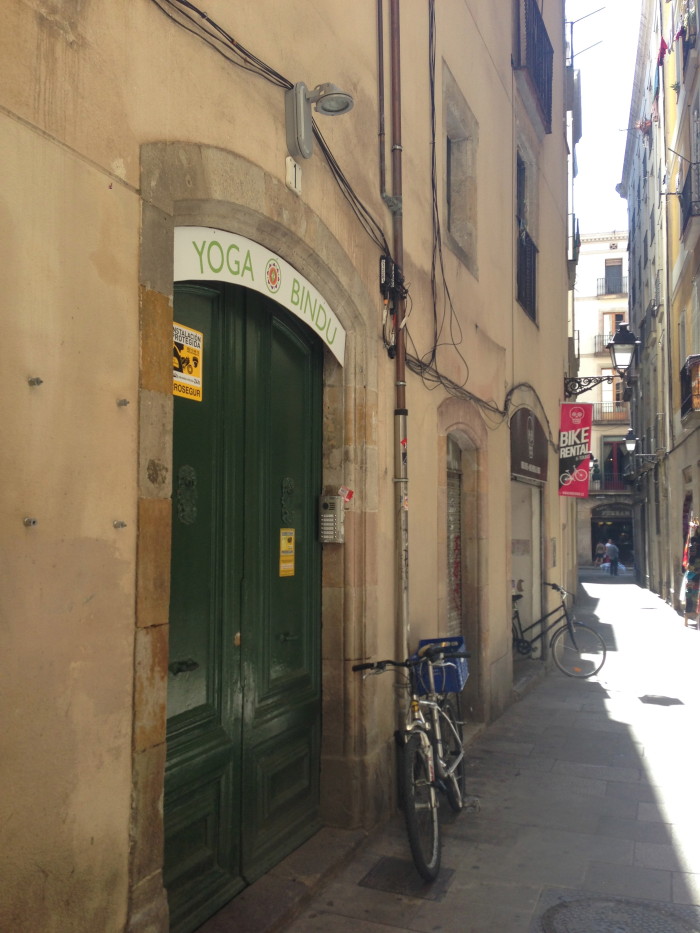
The Yoga Bindu studio, located on a small alley in the Barri Gothic in Barcelona is a respite for yoga enthusiasts in the busy city.
I thought that by allowing myself an hour to find the yoga studio in the Barri Gothic (the old quarter of Barcelona), that I would arrive in plenty of time for the 10 a.m. class.
But as I make my way through the tiny winding streets, I find myself lost in a labyrinth of twists and turns. And the erratic Wi-Fi coverage in Barcelona is not going to be of any assistance in finding my destination. Such is life in Spain.
In a last ditch effort, I pop into a bike rental shop, and a kind young man behind the counter points me to what appears to be an unmarked apartment building next door.
I find the understated signage refreshingly authentic. It’s almost as if saying, “you find me” as opposed to the commercialization of so many studios in the US that try to outdo each other with their over-the-top marketing.
It is 10:02, but I ring the buzzer. I’m prepared for them not to answer – or to politely turn me away. But I am buzzed in and quickly make my way up some ancient concrete stairway.
There is a friendly gal at the front desk to whom I dictate what is on the Google Translation of my iPhone: “Mi gustaria tomar la clase de yoga.” She takes my six Euro for the class and points me in the direction of the class. Thankfully, the numbers of the clock only serve as rough guidelines here, as opposed to strict start times.
I enter the room quietly so as not to disturb the class. Sitting cross-legged on my yoga mat, I listen to my yoga teacher’s melodic voice. She is leading us through a closed-eye meditation. My only challenge is that I have absolutely no idea what she is saying, because despite living in Spain for over a month, Catalan is still as foreign to me as when I first got here.
Having overcome the first challenge of actually finding the class, the reality of language barrier starts to set in as does the fact that I will likely make a complete fool of myself in class.
As the only non-Spanish/Catalan speaker in the class, I find myself hyper self-conscious. As a semi-advanced yoga practitioner/yoga teacher, I know how to get in and out of most poses – often without even thinking about it. But here I find myself with no idea what I am supposed to do now, nor any clue what is coming next.
“Inhalar,” the teacher brings me back to the room. “Exhalar.”
At least I understand the words to breathe.
The teacher goes on again with her dialogue and I am completely lost until I hear the word “ojos.”
Ojos – eyes, yes, I know this word! But is she telling us to open them or keep them closed? I open them, but everyone else still has them closed.
As we begin to move through the asanas, I am slow and awkward. It’s humbling. It was like I was taking yoga for the very first time.
That said, it is not too far along into the class that I realize no one is judging me. Each student is also struggling with their own practice, as I am with mine – just in different ways.
And there is the lesson I am having to constantly re-learn: I did not need to judge or have any other expectations of myself other than to just be in this moment, to go with the flow – and just do the best I could. With that, I let go of my ego.
No longer worrying about what the other students were thinking of my awkwardness, I immediately connect with them. When they breathe, I breathe. When they move their right leg, I move my right leg.
And when the teacher comes over to give me an adjustment, despite not understanding a word of what she says, I follow her body language instead of my brain.
As we lay in Savasana, I hear the church bells ringing outside, indicating that it is noon and that class is over. I open my eyes to see the puffy white clouds as they pass over the beautiful old Barri Gothic. I know I’m in the right place. And that really all the lessons in the yoga room are the ones I need to take off my mat with me. To allow myself to be a beginner in all things here abroad – a new language, a new culture, new people — new everything.
I close my eyes again and relish in the complete lightness of being so free. Namaste.
Tips for a Successful First Class in a Foreign Language:
-Have your route planned out to find your studio (this is particularly true in Barcelona, where studios can be tucked away on small side streets with little signage.) Better yet, visit the studio in advance, so you know where you are going.
-Place yourself in a middle row, if that’s an option. That way, you can also watch what other students are doing both in front of you and behind you, which is particularly helpful when you are in an asana that faces the back wall.
-Learn a few of the basic words before the class (right/left/eyes/mouth/open/close). Just a few of the basics can make a world of difference.
-Make sure you double-check schedules online as they can change weekly.
-Look out the window. And notice what’s there and where you are.
Also by Kirsten: From Dream to Destiny – Tips to Opening Your Own Studio
What I Learned from Unplugging from Facebook for a Year
Get more like this–sign up for our newsletter for exclusive inspirational content!




